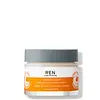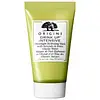What's inside
What's inside
 Key Ingredients
Key Ingredients

No key ingredients
 Benefits
Benefits

 Concerns
Concerns

 Ingredients Side-by-side
Ingredients Side-by-side

Water
Skin ConditioningCoco-Caprylate/Caprate
EmollientCetyl Alcohol
EmollientCetearyl Alcohol
EmollientCetyl Phosphate
EmulsifyingGlycerin
HumectantIsodecyl Neopentanoate
EmollientSimmondsia Chinensis Seed Oil
EmollientSqualane
EmollientArginine
MaskingBenzyl Alcohol
PerfumingPanthenol
Skin ConditioningGlycogen
HumectantSodium Dehydroacetate
PreservativeDehydroacetic Acid
PreservativeParfum
MaskingSucrose
HumectantPlankton Extract
Skin ConditioningLecithin
EmollientCitric Acid
BufferingSodium Hydroxide
BufferingCitral
PerfumingLimonene
PerfumingLinalool
PerfumingWater, Coco-Caprylate/Caprate, Cetyl Alcohol, Cetearyl Alcohol, Cetyl Phosphate, Glycerin, Isodecyl Neopentanoate, Simmondsia Chinensis Seed Oil, Squalane, Arginine, Benzyl Alcohol, Panthenol, Glycogen, Sodium Dehydroacetate, Dehydroacetic Acid, Parfum, Sucrose, Plankton Extract, Lecithin, Citric Acid, Sodium Hydroxide, Citral, Limonene, Linalool
Water
Skin ConditioningGlycerin
HumectantCetyl Alcohol
EmollientGlyceryl Polymethacrylate
Niacinamide
SmoothingHydroxyethyl Urea
HumectantPEG-75
HumectantDimethicone
EmollientPersea Gratissima Oil
Skin ConditioningPPG-15 Stearyl Ether
EmollientPEG-8
HumectantGlycereth-26
HumectantSorbitan Stearate
EmulsifyingCitrus Aurantium Amara Leaf/Twig Oil
MaskingCitrus Aurantium Dulcis Peel Oil
MaskingRicinus Communis Seed Oil
MaskingOsmanthus Fragrans Flower Extract
MaskingRosa Damascena Extract
MaskingRibes Nigrum Bud Extract
PerfumingCinnamomum Camphora Leaf Extract
MaskingBenzaldehyde
MaskingHexenyl Acetate
MaskingGamma-Decalactone
PerfumingIonone
AstringentEthyl Acetate
PerfumingAlcohol
AntimicrobialLinalool
PerfumingLimonene
PerfumingIsopropyl Isostearate
EmollientPEG-100 Stearate
Citrus Aurantium Dulcis Peel Wax
Skin ConditioningPrunus Armeniaca Kernel Oil
MaskingMangifera Indica Seed Butter
Skin ConditioningSucrose
HumectantHypnea Musciformis Extract
Skin ProtectingAvena Sativa Kernel Extract
AbrasiveTriticum Vulgare Bran Extract
Skin ConditioningCladosiphon Okamuranus Extract
Skin ConditioningCetearyl Alcohol
EmollientCaffeine
Skin ConditioningOryza Sativa Extract
AbsorbentGelidiella Acerosa Extract
Skin ProtectingButylene Glycol
HumectantAloe Barbadensis Leaf Extract
EmollientPantethine
EmollientOlea Europaea Fruit Extract
BleachingCocos Nucifera Oil
MaskingPunica Granatum Sterols
Skin ConditioningSorbitol
HumectantCaprylyl Glycol
EmollientTocopheryl Acetate
AntioxidantOryzanol
Skin ConditioningTrehalose
HumectantBisabolol
MaskingCetyl Ethylhexanoate
EmollientSodium Hyaluronate
HumectantCarbomer
Emulsion StabilisingHexylene Glycol
EmulsifyingPotassium Hydroxide
BufferingDextrin
AbsorbentDisodium EDTA
Potassium Sorbate
PreservativePhenoxyethanol
PreservativeAquilaria Agallocha Wood Oil
MaskingWater, Glycerin, Cetyl Alcohol, Glyceryl Polymethacrylate, Niacinamide, Hydroxyethyl Urea, PEG-75, Dimethicone, Persea Gratissima Oil, PPG-15 Stearyl Ether, PEG-8, Glycereth-26, Sorbitan Stearate, Citrus Aurantium Amara Leaf/Twig Oil, Citrus Aurantium Dulcis Peel Oil, Ricinus Communis Seed Oil, Osmanthus Fragrans Flower Extract, Rosa Damascena Extract, Ribes Nigrum Bud Extract, Cinnamomum Camphora Leaf Extract, Benzaldehyde, Hexenyl Acetate, Gamma-Decalactone, Ionone, Ethyl Acetate, Alcohol, Linalool, Limonene, Isopropyl Isostearate, PEG-100 Stearate, Citrus Aurantium Dulcis Peel Wax, Prunus Armeniaca Kernel Oil, Mangifera Indica Seed Butter, Sucrose, Hypnea Musciformis Extract, Avena Sativa Kernel Extract, Triticum Vulgare Bran Extract, Cladosiphon Okamuranus Extract, Cetearyl Alcohol, Caffeine, Oryza Sativa Extract, Gelidiella Acerosa Extract, Butylene Glycol, Aloe Barbadensis Leaf Extract, Pantethine, Olea Europaea Fruit Extract, Cocos Nucifera Oil, Punica Granatum Sterols, Sorbitol, Caprylyl Glycol, Tocopheryl Acetate, Oryzanol, Trehalose, Bisabolol, Cetyl Ethylhexanoate, Sodium Hyaluronate, Carbomer, Hexylene Glycol, Potassium Hydroxide, Dextrin, Disodium EDTA, Potassium Sorbate, Phenoxyethanol, Aquilaria Agallocha Wood Oil
 Reviews
Reviews

Ingredients Explained
These ingredients are found in both products.
Ingredients higher up in an ingredient list are typically present in a larger amount.
Cetearyl alcohol is a mixture of two fatty alcohols: cetyl alcohol and stearyl alcohol. It is mainly used as an emulsifier. Emulsifiers help prevent the separation of oils and products. Due to its composition, it can also be used to thicken a product or help create foam.
Cetearyl alcohol is an emollient. Emollients help soothe and hydrate the skin by trapping moisture.
Studies show Cetearyl alcohol is non-toxic and non-irritating. The FDA allows products labeled "alcohol-free" to have fatty alcohols.
This ingredient is usually derived from plant oils such as palm, vegetable, or coconut oils. There is debate on whether this ingredient will cause acne.
Due to the fatty acid base, this ingredient may not be Malassezia folliculitis safe.
Learn more about Cetearyl AlcoholCetyl Alcohol is a fatty alcohol. Fatty Alcohols are most often used as an emollient or to thicken a product.
Its main roles are:
Though it has "alcohol" in the name, it is not related to denatured alcohol or ethyl alcohol.
The FDA allows products labeled "alcohol-free" to have fatty alcohols.
Learn more about Cetyl AlcoholGlycerin is already naturally found in your skin. It helps moisturize and protect your skin.
A study from 2016 found glycerin to be more effective as a humectant than AHAs and hyaluronic acid.
As a humectant, it helps the skin stay hydrated by pulling moisture to your skin. The low molecular weight of glycerin allows it to pull moisture into the deeper layers of your skin.
Hydrated skin improves your skin barrier; Your skin barrier helps protect against irritants and bacteria.
Glycerin has also been found to have antimicrobial and antiviral properties. Due to these properties, glycerin is often used in wound and burn treatments.
In cosmetics, glycerin is usually derived from plants such as soybean or palm. However, it can also be sourced from animals, such as tallow or animal fat.
This ingredient is organic, colorless, odorless, and non-toxic.
Glycerin is the name for this ingredient in American English. British English uses Glycerol/Glycerine.
Learn more about GlycerinLimonene is a fragrance that adds scent and taste to a formulation.
It's found in the peel oil of citrus fruits and other plants such as lavender and eucalyptus. The scent of limonene is generally described as "sweet citrus".
Limonene acts as an antioxidant, meaning it helps neutralize free radicals.
When exposed to air, oxidized limonene may sensitize the skin. Because of this, limonene is often avoided by people with sensitive skin.
The term 'fragrance' is not regulated in many countries. In many cases, it is up to the brand to define this term. For instance, many brands choose to label themselves as "fragrance-free" because they are not using synthetic fragrances. However, their products may still contain ingredients such as essential oils that are considered a fragrance.
Learn more about LimoneneLinalool is a fragrance and helps add scent to products. It's derived from common plants such as cinnamon, mint, citrus, and lavender.
Like Limonene, this ingredient oxidizes when exposed to air. Oxidized linalool can cause allergies and skin sensitivity.
This ingredient has a scent that is floral, spicy tropical, and citrus-like.
Learn more about LinaloolSucrose is a natural sugar found in fruits, vegetables, and nuts. It is the main constituent of white sugar.
In skincare, sucrose is a humectant and can be a mild exfoliant.
Sucrose is hydrophilic, meaning it attracts water. This makes it an effective humectant and helps hydrate the skin.
Studies show sugars may worsen acne-prone skin due to it disrupting the skin's natural biome. We recommend speaking with a professional if you have any concerns.
In some products such as body scrubs, sucrose is used as an gentle exfoliant.
The term 'sucrose' comes from the french word for sugar, 'sucre'.
Learn more about SucroseWater. It's the most common cosmetic ingredient of all. You'll usually see it at the top of ingredient lists, meaning that it makes up the largest part of the product.
So why is it so popular? Water most often acts as a solvent - this means that it helps dissolve other ingredients into the formulation.
You'll also recognize water as that liquid we all need to stay alive. If you see this, drink a glass of water. Stay hydrated!
Learn more about Water